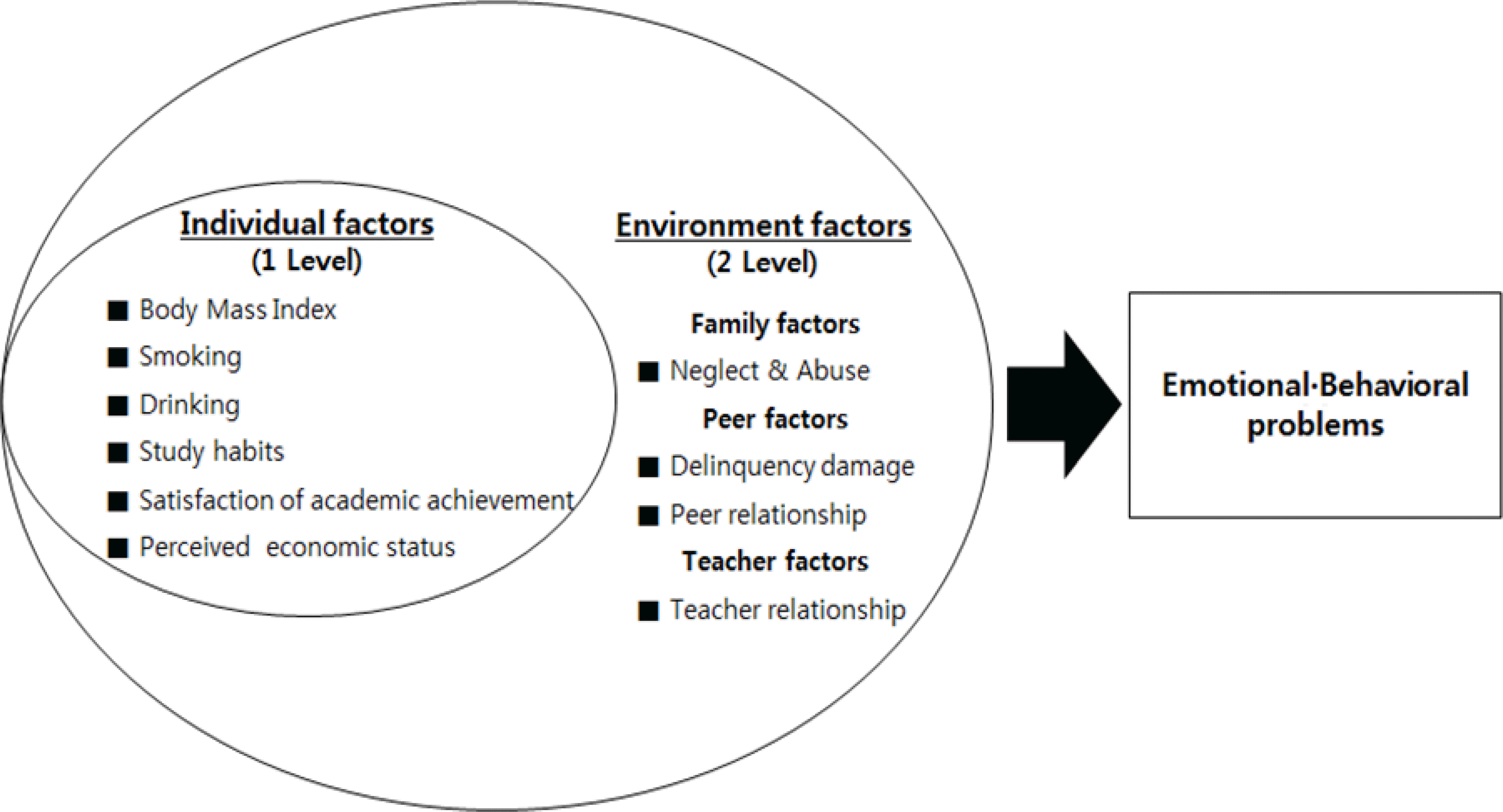Abstract
Purpose
This study aims to investigate the individual and environmental factors related to emotional/behavioral problems to early adolescence in Korea by applying multilevel modeling.
Methods
From the database of the 2014 Korean Child and Youth Panel Survey (KCYPS), the researchers selected 1,977 adolescents who are in the second year of middle school. Multilevel model analysis was performed to estimate the impact of relevant factors at the individual and environmental levels.
Results
At the individual level, the significant factors associated with emo-tional/behavioral problems included BMI and study tendency in boys, and drinking, study tendency and economic levels in girls. At the environmental level, the significant factor associated with emotional/behavioral problems included relationship with the teacher.
Go to : 
References
1. Kim YE, Lee GN. The relationship among social support, self-esteem and problem behaviors in middle-school students. Elementary School Education Research. 2013; 18:133–145.
2. Ministry of Education. Korean Educational Development Institute. Development of standardized personality test for elementary and secondary students [Internet]. Seoul: Korean Educational Development Institute;2014. [cited 2017 April 13]. Available from:. http://www.kdi.re.kr/policy/ep_view.jsp?idx=134891.
3. Lee HL, Hong SW, Chae SH, Lee JM, Kim SW. Juvenile delinquency and counseling. 2nd ed. Pa-ju: Kyoyookbook;2015. p. 376.
4. Baek SY, Lee SH. Differences in the degree and clinical risk of emotional and behavioral problems in children and adolescents according to school levels and gender. Journal of Emotional & Behavioral Disorders. 2014; 30(2):207–231.
5. Park HG, Heo JH. The effect child abuse has the emotional and behavioral problems in the youth: Focusing on the mediation effect of peer relationship. Journal of School Social Work. 2016; 36:23–46.
6. Kauffman JM, Landrum TJ. Characteristics of emotional and behavioral disorders of children and youth. 9th ed. New York: Pearson Education;2008. p. 569.
7. Kang SJ. Multilevel models. 1st ed. Seoul: Hakjisa;2016. p. 478.
8. Jang MJ, Sim HO. The change of the internal world in middle school girls having emotional and behavioral difficulties by exploring their sand play. Korean Journal of Child Studies. 2017; 38(1):95–116. https://doi.org/10.5723/kjcs.2017.38.1.95.
9. Hwang HG. 60,000 elementary, junior and high school students need psychological counseling. The Yonhapnews. 2016; September 21.
10. Lee HJ, Seo MA. Factors influencing somatization in adolescents. The Journal of the Korean society of school Health. 2010; 23(1):79–87.
11. Baek, SY. Variance analysis on the children ․ youth emotional behavior problems in gender and academic achievement level. The Journal of Humanities and Social Science. 2016; 7(5):659–675. https://doi.org/10.22143/HSS21.7.5.34.
12. Kim SS. The influence of family relationship perceived by adolescents upon depression/anxiety, withdrawn behavior, and aggression: Moderating effect of teacher support and friend support. The Korea Journal of Youth Counseling. 2013; 21(2):343–364.
13. Kim JM, Jang YH. Effects of adolescent stress on somatic symptoms: The moderating effects of social support. The Korean Journal of Stress Research. 2015; 23(4):187–196. https://doi.org/10.17547/kjsr.2015.23.4.187.

14. Yune SJ, Ju JH, Lee EY. Relationships among perceived social support systems, class cohesiveness, and school adaptation in adolescence. The Journal of Yeolin Education. 2013; 21(2):185–207.
15. Kim JU, Choi MS. Analysis of the structural relationship among family strength, social support, ego-resilience, hope, peer relational skills and problem behavior or adolescents. The Korea Journal of Youth Counseling. 2014; 22(1):201–226.
16. Cho YM, Lee S. The effects of child temperament maternal child-rearing attitudes and social support on internalizing disorders and externalizing disorders. Korean Journal of Child Psychotherapy. 2015; 10(3):21–39.
17. Kim EY. Parental child rearing attitudes and adolescence' somatic symptoms: On the mediating effects of depression. Journal of Learner-Centered Curriculum and Instruction. 2016; 16(8):457–473.
18. Ahn YH, Ham OK, Kim SH, Park CG. Multilevel analysis of health care service utilization among medical aid beneficiaries in Korea. Journal of Korean Academy of Nursing. 2012; 42(7):928–935. https://doi.org/10.4040/jkan.2012.42.7.928.

19. Kim YH. The effects of individual, family, and peer factors on the internalizing and externalizing problem behavior of adolescents. Family and Environment Research. 2014; 52(4):371–382. https://doi.org/10.6115/fer.2014.032.

20. Giannakopoulos G, Tzavara C, Dimitrakaki C, Kolaitis G, Rotsika V, Tountas Y. Emotional, behavioural problems and cigarette smoking in adolescence: Findings of a Greek cross-sectional study. BioMed Central Public Health. 2010; 10:57–63. https://doi.org/10.1186/1471-2458-10-57.

21. Jung SM, Park CH, Kim TH, Gegal YS. Investigation of the physical activity participation time, the level of physical fitness and health status among children and adolescents at diet clinic. Journal of Wellness. 2016; 11(2):429–440. https://doi.org/10.21097/ksw.2016.05.11.2.429.

22. Huang L, Tao FB, Wan YH, Xing C, Hao J, Su PU, Xing XY. Self-reported weight status rather than BMI may be closely related to psychopathological symptoms among Mainland Chinese adolescents. Journal of Tropical Pediatrics. 2011; 57(4):307–311. https://doi.org/10.1093/tropej/fmp097.

23. Kim DS, Kim HS. Body-image dissatisfaction as a predictor of suicidal ideation among Korean boys and girls in different stages of adolescence: A two-year longitudinal study. Journal of Adolescent Health. 2009; 45(1):47–54. https://doi.org/10.1016/j.jadohealth.2008.11.017.

24. Shin KL. Gender difference analysis for status offenses of middle school students: Leisure types, attachments, and negative affection oriented approach. Journal of Leisure Studies. 2015; 13(2):179–205.
25. Patrick ME, Schulenberg JE. Prevalence and predictors of adolescent alcohol use and binge drinking in the United States. Alcohol Research: Current Reviews. 2013; 35(2):193–200.
26. Lee YR, Park EJ, Lee SH. A study on the variation of academic achievement and life satisfaction of middle school students contrasted by study habit type. Journal of Learner-Centered Curriculum and Instruction. 2015; 15(11):621–641.
27. Bae JS. The effect of parenting behavior, emotion control, future goal on study habits of adolescents. Journal of Brain Education. 2017; 19(0):51–71.
28. Sweeting H, Hunt K. Adolescent socio-economic and school-based social status, health and well-being. Social science & medicine. 2014; 121:39–47. https://doi.org/10.1016/j.socscimed.2014.09.037.

Go to : 




 PDF
PDF ePub
ePub Citation
Citation Print
Print



 XML Download
XML Download